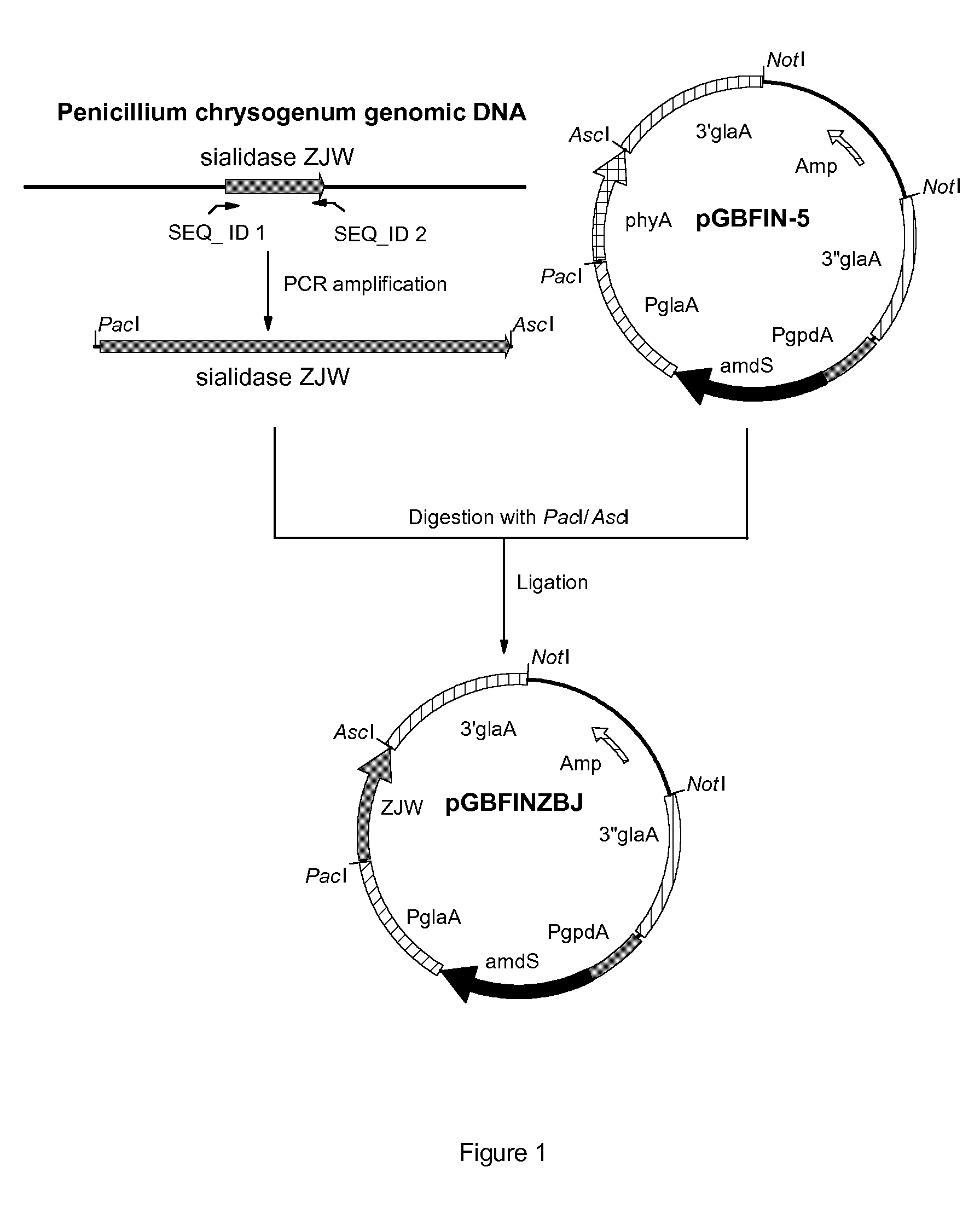Novel sialidases
a technology of sialidases and sialidases, applied in the field of new sialidases, can solve the problems of affecting the biological properties and physical characteristics of such substances, affecting the ability to hide from the immune system, and masking can also have a detrimental effect, and achieve the effect of high stringency
- Summary
- Abstract
- Description
- Claims
- Application Information
AI Technical Summary
Benefits of technology
Problems solved by technology
Method used
Image
Examples
example 1
Cloning and Expression of the Sialidase Gene ZJW
[0158]Penicillium chrysogenum strain Wisconsin 54-1255 (ATCC28089) was grown for 3 days at 30 degrees Celsius in PDB (Potato dextrose broth, Difco) and chromosomal DNA was isolated from the mycelium using the Q-Biogene kit (catalog nr. 6540-600; Omnilabo International BV, Breda, the Netherlands), using the instructions of the supplier. This chromosomal DNA was used for the amplification of the coding sequence of the sialidase gene using PCR.
[0159]To specifically amplify the sialidase gene ZJW from the chromosomal DNA of Penicillium chrysogenum strain Wisconsin 54-1255 (ATCC28089), two PCR primers were designed. Primer sequences were partly obtained from a sequence that was found in the genomic DNA of Penicillium chrysogenum Wisconsin 54-1255 (ATCC28089) and is depicted in SEQ ID NO: 1. We found that this sequence has homology with sialidase sequences of Actinomyces and Arthrobacter. However, no homologous fungal sialidases have been de...
example 2
Purification and Characterization of the Sialidase
[0165]Sialidase was produced via fermentation as described in Example 1. Enzyme activity was measured using the Amplex Red neuraminidase assay kit (obtained from Invitrogen). Culture filtrate (100 ml) was diluted with milliQ-water to a conductivity of 4.8 mS / cm and concentrated to 70 ml by ultrafiltration using a Biomax-10 membrane (obtained from Millipore). The pH was adjusted to 6.0 using NaOH and the sample was loaded on a 5 ml HiTrapQ ion exchange column (obtained from Amersham, 5 ml / min), equilibrated in 20 mM sodium citrate (pH6.0). The flow through of the column, containing the sialidase, was collected and dialyzed against 25 mM Tris, HCl (pH7.0) and loaded on a 5 ml HiTrap Q FF (5 ml / min), equilibrated in the same buffer. The sialidase was present in the flow-through fraction and was collected. The enzyme solution was then dialyzed against 30 mM sodium citrate (pH4.0, buffer A) and applied on a 5 ml HiTrap SP column (obtained...
example 3
Method of Preparation of Miniature Cheeses
[0166]Miniature cheeses were produced as described by Shakeel-Ur-Rehman et al. (Protocol for the manufacture of miniature cheeses in Lait, 78 (1998), 607-620). Pasteurized full fat homogenized cows milk was used, but raw cows milk or reconstituted cows milk can also be used. The milk was transferred to wide mouth plastic centrifuge bottles (200 mL per bottle) and cooled to 31° C. Subsequently, 1.8 Units of starter culture DS 5LT1 (DSM Gist B. V., Delft, The Netherlands) were added to each of the 200 ml of pasteurized milk in the centrifuge bottles and the milk was ripened for 20 minutes. Then, CaCl2 (132 μL of a 1 mol·L−1 solution per 200 mL ripened milk) was added. Finally the coagulant was added (0.04 IMCU per ml); when sialidase was used, this was added together with the coagulant. The milk solutions were held for 40-50 minutes at 31° C. until a coagulum was formed. The coagulum was cut manually by cutters of stretched wire, spaced 1 cm a...
PUM
| Property | Measurement | Unit |
|---|---|---|
| Fraction | aaaaa | aaaaa |
| Fraction | aaaaa | aaaaa |
| Fraction | aaaaa | aaaaa |
Abstract
Description
Claims
Application Information
 Login to View More
Login to View More - R&D
- Intellectual Property
- Life Sciences
- Materials
- Tech Scout
- Unparalleled Data Quality
- Higher Quality Content
- 60% Fewer Hallucinations
Browse by: Latest US Patents, China's latest patents, Technical Efficacy Thesaurus, Application Domain, Technology Topic, Popular Technical Reports.
© 2025 PatSnap. All rights reserved.Legal|Privacy policy|Modern Slavery Act Transparency Statement|Sitemap|About US| Contact US: help@patsnap.com

